
Velocity dispersions suggest that about 90% of the mass in clusters is not in individual galaxies. Amounts of mass comparable to that in the galaxies (but not the dynamical total) are implied by X-ray emission from hot gas and radio "tails" bent by galaxy motion through an intracluster medium.
Cluster X-ray sources have been reviewed by Forman and Jones 1982 (ARA&A 20, 547) and Sarazin 1986 (Rev. Mod. Phys. 58, 1). The gas has temperature 4-7 keV corresponding to the temperature associated with the cluster velocity dispersion and spectra consistent with thermal brehmsstrahlung. The gas is not usually associated with individual galaxies, unless a dominant one is at the center of the cluster potential: from Fig 1 of Forman and Jones (taken from the ADS), one can see the range in X-ray morphologies, from the dispersed and irregular morphology of the clusters on the left to the increasingly concentrated forms on the right. Since it's illegible on the scan, the left column contains A1367, SC 0627-54, and A2256, while on the right we see A262, 2199 (a prominent cD cluster), and 85. There's a large collection of optical/X-ray comparisons available among Ray White's cluster mug shots

This XMM-Newton view of the Coma cluster shows the internal structure of even such a rich and relaxed assemblage (ESA image):
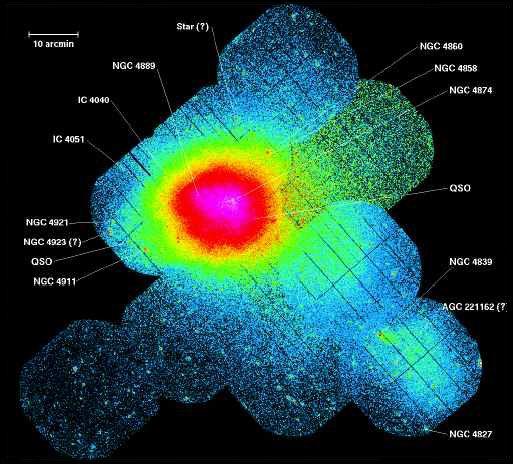
The X-ray spectra reveal lines of highly ionized Fe, indicating that the gas has been processed - it came from galaxies early on, rather than being primordial. The galaxy motions in the cluster are an ample (but perhaps not the only) heating source, since kT ~ mpv2. A typical velocity dispersion 700 km/s implies T ~ 6 x 107 K from this source alone. Extra heating sources may be sought from the correlation between velocity dispersion and ICM temperature, or considering the specific entropy of the gas.
The hot gas has a very long cooling time (of order the Hubble time) except in denser areas, which can produce a cooling flow onto individual galaxies or in cluster cores. This happens because of the interesting behavior of the cooling rate for hydrogen-dominated plasmas as a function of temperature and density; since brehmsstrahlung is important, the ne2 dependence can pull the rug out from under a pressure-supported gas. That is, for a purely cooling plasma, the time it spends at a given temperature is inversely related to the efficiency of cooling at that temperature, so that it drops rapidly through temperature regimes where cooling is strong (such as through optical and UV line emission) and slowly through regimes with very weak cooling, such as 107 K at low density. Cooling flows have been suggested as a way to build central cluster galaxies over cosmic time, but (with a few notable exceptions such as Abell 1795) there's no trace of the massive star formation expected if the gas is being dumped into the center. There are (of course) models in which the stars are all very low mass and conveniently unobservable, but the role of nonradial flow and magnetic fields may well defeat those last few kiloparsecs. It has also been wdely suggested that AGN outbursts heat the IC sufficiently to dafeat cooling flows; evidence includes finding places where the radio plasma from double sources has shoved the hot gas around, and waves indicating kinetic-energy input.
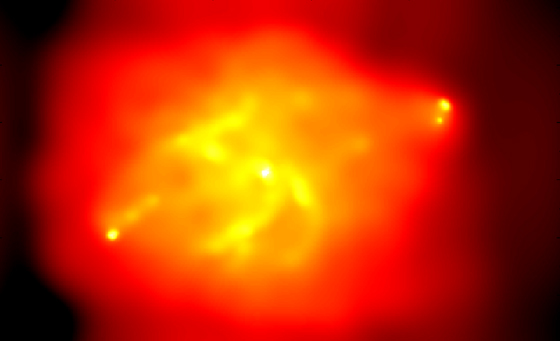
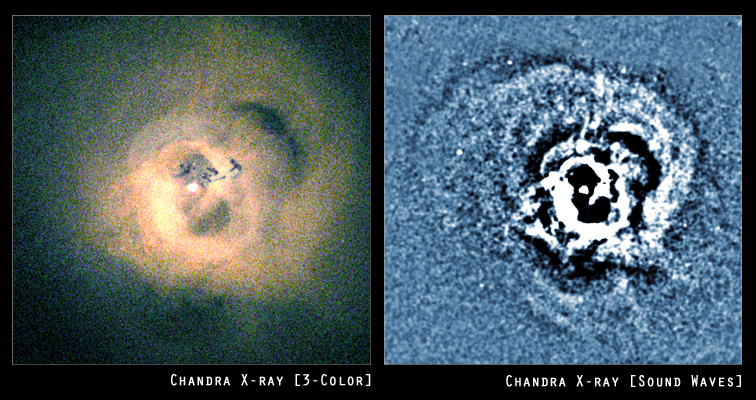
Cluster X-ray emission is perhaps a better tracer of dynamical evolution than galaxy counts, since it is smooth and not limited by galaxy statistics. This is also the technique of choice for finding distant clusters (as extended X-ray sources) since confusion at faint magnitudes makes optical identification difficult and unreliable. Note that the total mass of gas usually exceeds that in stars for a typical cluster.
Spectroscopy of the hot intracluster medium has proven very revealing of its likely history. By the advent of ASCA, X-ray features from specific ions could be resolved, so it was possible to examine the relative abundances of heavy elements to tell where they came from. In particular, the contributions of different kinds of supernovae (from different progenitor mass ranges) could tell what the early star-forming history of the cluster galaxies was like, and the abundance structure could tell whether virial motions or the energy input from galactic winds is more important. As an example, here are ASCA spectra of the inner and outer regions of Abell 496, from Dupke and White 2000 (ApJ 537, 123, by permission of the AAS).

This plot shows clearly the reduced metallicity in the outer regions. Comparison of the abundances of these elements (Fe, Ni, Si, S, Mg) suggests that type II SN contributed everywhere, with type Ia most important in the inner parts of clusters (a sensible thing if much of the mixing happened early on, since type IIs would have gone off before type Ia's). There is some evidence that significant heating can occur from supernova-driven winds, on top of the virial heating simply from being in equilibrium in the cluster potential. It was believed for some time, from the Einstein serendipity survey, that the X-ray luminosity function of clusters showed string evolution from about z=0.5 to the present in the direction of clusters brightening over time, but more complete ROSAT data call this into question and suggest that cluster X-ray properties have been nearly constant since z=0.7 (the WARPS survey - Fairley et al. 2000 MNRAS 315, 669; and Schindler 1999 A&A 349, 435). Out to redshifts of order 1, X-ray emission is the best way to identify rich groupings of galaxies, since detection of diffuse emission is less subject to projection biases than enhancements in projected galaxy density.
Such abundance studies also give hints that clusters are leaky, especially for less massive (by and large cooler) examples. Fukazawa et al. (1998 PASJ 50, 187) show a very clear correlation between Si/Fe ratio and cluster temperature (shown below from their Fig. 3, from the ADS). Cooler clusters (shallower potential) have ratios characteristic of Sn Ia, while hot (massive) clusters have ratios close to the SN II production value. This suggests that only the most massive clusters have retained most of the ejecta from the initial burst of SN II, while most of the metals in poor clusters have come from more recent SN Ia. In a similar vein, comparison of gas temperatures to the expected virial temperature corresponding to the galaxies' velocity dispersion shows that hotter clusters match well (the ratio, known as the β parameter, is close to unity) while for cooler clusters, the gas is too hot, indicating that the energy input from galactic winds (presumably driven by the enriching supernovae) is important compared to these shallower potentials.
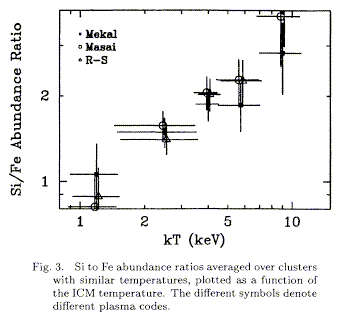
The presence of significant hot gas sets in somewhere in the group scale, as in the notorious NGC 2300 ROSAT report (Mulchaey et al. 1993 ApJL 404, L9). However, the detections of diffuse X-ray matter in groups are spotty, perhaps dependent on the galaxy types (being more likely when there are ellipticals present).
Head-tail radio galaxies are often found in clusters. These are heavily distorted double sources that exhibit a swept-back appearance. The most promising explanation for this is motion of the galaxy with respect to an external medium, and bending of low-velocity radio jets by ram pressure of the external medium (Begelman et al 1979 Nature 279, 770). The type examples are 3C 129, NGC 1265, and IC 310 (there are three in the Perseus cluster alone). From O'Dea and Owen 1986 (ApJ 301, 841, courtesy of the AAS), here is a detailed view of the inner parts of the radio source in NGC 1265. The prominent flares in each tail may represent transitions from the ISM to the surrounding material in the cluster.
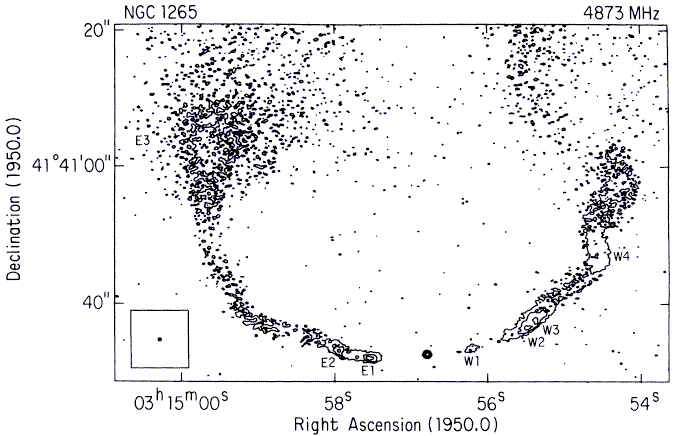
Knowing statistically what galaxy speeds in clusters are, we could deduce the density of the ICM if we knew the jet speed and density - the big problem. Also, other mechanisms for bending have been considered (Jones and Owen 1979 ApJ 234, 818). Detailed radio maps favor the less direct interpretation of ISM distortions induced by ram pressure, but not uniquely. We just need to understand jets better..
A few clusters exhibit diffuse radio emission which presumably comes from some component of the ICM. Note that the hot gas is what produces the Suyaev-Zeldovich absorption against the microwave background.
As many as 10% of rich clusters have been found to contain strong far-IR sources. Neither IRAS nor ISO had the angular resolution to locate the emission too precisely, but the best-contending explanation seems to be dust ejected from a galaxy's own ISM during a tidal encounter now being heated by impact from the electrons in the hot IGM (Cox et al. 1997 BAAS 106.03, 1995 ApJS 99, 405; Hansen et al. 1999 A&A 349, 406). Individual galaxies are unlikely as the source because the far-IR luminosity is very high (1044-45 erg/s) for the kinds of galaxies that are present. This phase is likely to be short-lived because (1) so few clusters show such far-IR sources, (2) grains have relatively short lifetimes against sputtering by such energetic impacts, and (3) the IR luminosity is a large fraction of the X-ray luminosity; that is, the dust is an effective coolant for the whole IGM, so it would poison the X-ray emission if it were long-lasting and widespread.
Last changes: 10/2009 © 2000-9